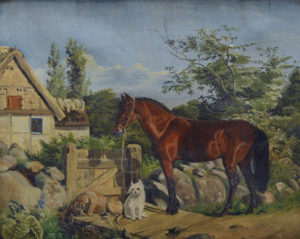QUESTION OF THE WEEK: June 21, 2021.
Do you have a question and want to possibly be featured? E-mail me here and I’ll do my best to answer. Be sure to include QUESTION OF THE WEEK as the subject line. Keep in mind my answers here are mostly general and should not take the place of a formal appraisal.
QUESTION: “How do you value a painting that is unsigned or by an unknown artist?” Peter from Chicago, Illinois.
Answer: It’s not uncommon to come across paintings that are unsigned, unattributed with no provenance beyond “It’s been in our family forever.” It’s also somewhat common to come across signed works with solid provenance by artists with little notoriety. Obviously, signed paintings or those attributed to a particular artist are easier to value as one can review auction records or gallery asking prices for comparable works. When a client tells me a painting is unsigned, I still go over it with a fine-toothed comb just in case something jumps out. But if nothing does these are some of the things I look for to generate a potential value:
- Medium. Is it an oil on canvas? Is it a watercolor? Acrylic? A combination? Once I can pinpoint the medium, I can refine my research to other works with similar materials.
- Size. It’s not a concrete rule, but larger works generally take more time to complete and thus fetch more money at auction or in a gallery. This is a loose rule, but it may factor in.
- Subject matter. This is subjective, but in my years as a buyer for my family’s stores and an appraiser, I’ve picked up on a few things: Portraits by unknown artists of unknown subjects can be a hard sell. Landscapes and still life paintings fair pretty well as do some abstract works. And for reasons I’ve never fully understood, buyers love horse paintings. Love them.
- Style. This relates to schools of painting or art movements. General styles may include abstractionism, surrealism, impressionism, expressionism and others. To refine it further one might consider the school of painting. Is it an American School portrait or a Dutch School? Is it a Hudson River School landscape or a Barbizon? Narrowing it down can then help find comparable pieces.
- Condition. Of course condition plays a factor in determining value, it always does. With older paintings, dust buildup can really do a number on an item’s value. The dust can buildup for decades or even centuries and really dull the colors. That’s why museums pay a lot of money for cleaning and restorations. Buyers are naturally attracted to brighter paintings – your eye is instinctively drawn to them.
So these are some of the starting points one can piece together to generate values on unsigned works or those by little known artists.
Have more questions? E-mail me at grantmiller@grantmillerappraisals.com. In Illinois and looking for an antiques appraisal? Call or text me at 813-240-4586 (Chicago and elsewhere).